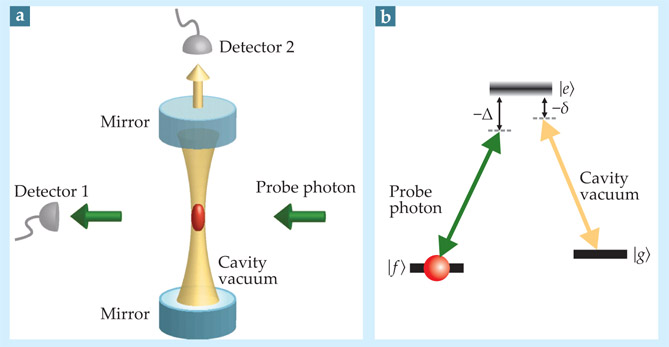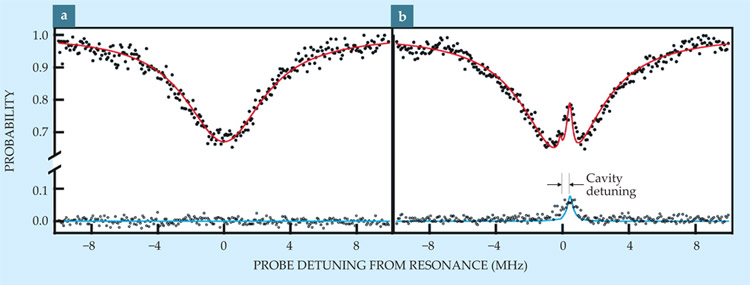Opaque atoms turn transparent in the vacuum field of an optical cavity
DOI: 10.1063/PT.3.1318
Nearly 20 years ago, while working on atomic systems that can lase without inversion, Stanford University doctoral student John Field made a bold prediction. Given a cloud of three-level atoms that are opaque to a light beam, he argued, simply placing the atoms between two closely spaced mirrors can make it transparent to the same beam. 1 A group led by MIT’s Vladan Vuletić has now experimentally demonstrated the unusual effect using an exceedingly weak light beam—pulses containing a few or even single photons—focused into an ensemble of about 105 cesium atoms. 2 The effect is not small: They see a 40% reduction in absorption probability that appears to emerge out of the quantum blue—induced by the electromagnetic vacuum field in the empty space of an optical cavity. Additional photons injected into the cavity reduce the absorption further still.
The achievement is part of a larger effort over the past couple of years by research groups to combine two workhorse techniques from quantum optics—electromagnetically induced transparency (EIT; see the article by Stephen Harris in PHYSICS TODAY, July 1997, page 36
EIT meets cavity QED
Fast, ubiquitous, and easily detected, photons are ideal carriers of information. Normally they just pass through each other without consequence. So, to tackle a central challenge—controlling the quantum state of one photon using another—researchers turn to atoms as intermediaries. The conceptually simplest approach is to store the photon’s state in an atom, or a collection of them, whose coherent response can then subsequently affect another photon.
A single atom, though, simply doesn’t absorb a single photon efficiently enough. Placing the atom in a cavity provides an elegant solution. Light that shines along the axis of the cavity repeatedly reflects from its mirrors, and the hundreds of thousands of round trips dramatically increase the atom’s absorption cross section. If the mirror spacing is tuned so that the cavity resonates at the frequency of a transition between two electronic states of the atom, the photon and atom become strongly coupled and coherently exchange energy at a rate that exceeds the decay of the system.
At that resonance frequency, atoms normally repeatedly absorb and reemit the photons. Curiously, atoms can fail to absorb radiation when more than two atomic states are involved, a phenomenon discovered by Ugo Fano half a century ago. In atoms that exhibit the effect, destructive interference between two alternate pathways leading to the same excited state eliminates the absorption. In 1991 Field, Stephen Harris (his thesis adviser), Atac Imamoglu (ETH Zürich), and Klaus Boller (University of Twente) showed how to tailor those Fano-type interferences using two optical fields tuned to the separate transition pathways—the EIT technique (see PHYSICS TODAY, May 1992, page 17
Last year a group led by Gerhard Rempe at the Max Planck Institute of Quantum Optics in Garching, Germany, and, separately, a group led by Dieter Meschede at the University of Bonn implemented the EIT scheme using optical cavities that each contained a single trapped atom—rubidium in one case, 3 cesium in the other. 4 Per the standard protocol, each group pumped its atom along transitions from two neighboring hyperfine ground states to a single excited state: one transition driven by a control laser that “dresses” the excited states and determines the atom’s optical response to another, probe laser, incident along the cavity. The control laser could turn on or off the probe’s absorption by the atom, and thus the research groups had created the equivalent of an optical transistor.
The vacuum field
In the new work, Vuletić’s group opted to squeeze not a single atom into their cavity but a mesoscopic number of them. That decision saved them from a lot of overhead that accompanies work on single atoms, but more importantly, it also allowed them to swap the role of the cavity with that of a control beam. Unlike a single atom, which requires a cavity to amplify its influence on the weak probe field, 105 atoms are efficient absorbers of a few or even a single photon.
In the MIT approach, a weak probe pulse shines on a cloud of Cs atoms from the side, as illustrated in figure 1. The mirrors’ ultrahigh reflectivity traps scattered photons in the cavity, which amplifies their electric field, guarantees strong coupling, and thus ensures that incoming photons are most likely to scatter into a single mode of the resonator. Indeed, that was Field’s original prediction: In the strong-coupling regime, fluctuations in the electromagnetic vacuum field are sufficient to induce transparency in the atoms—no control beam required—an effect that’s been dubbed vacuum-induced transparency (VIT). Without the vacuum field of the cavity, spontaneous emission from an excited state would send a scattered photon in some random direction where it would be lost in space.

Figure 1. Vacuum-induced transparency.(a) Photons in a probe pulse experience Raman scattering as they interact with a cloud of three-level cesium atoms (red) in an optical cavity. The photons are absorbed and quickly emitted into the cavity, where, after some time delay they are reabsorbed and reemitted collectively—that is, in a way mediated by the response of all the atoms—as an identical probe pulse. Detectors 1 and 2 measure the probe transmission and scattering in the cavity, respectively. (b) During the interaction, two transitions from Cs hyperfine states |f〉 and |g〉 to an excited state ∣e〉 are simultaneously driven by the probe field and the cavity field, respectively. When both fields are either on resonance or detuned from it by the same amount, δ ≈ Δ, coherence between the two hyperfine states cancel the absorption. (Adapted from ref.

The signature event in VIT, shown in figure 2, is the emergence of a narrow increase in the light transmission when the probe-photon and cavity-vacuum frequencies are both in or near resonance with the two ground state–excited state transitions (figure 1). At those resonance frequencies, the probe absorption and cavity-mode absorption destructively interfere. Crucially, and unlike in EIT, a probe pulse plays dual roles and creates its own transparency: After being absorbed by the atom cloud, a probe photon scatters into the cavity mode, and its reabsorption in that mode by the cloud of atoms renders the cloud transparent to the same probe photon. Eventually, the photon is converted back into the probe pulse, which then exits the system and is detected.

Figure 2. The probabilities of transmission through the cavity (red) and of emission into it (blue) are measured by the two photon-counting detectors sketched in figure

Vuletić’s group explicitly measured the influence of the vacuum field on the improvement in the atoms’ transparency when the cavity is filled with up to 10 probe photons. The collective improvement increased sublinearly as each photon was added: The transparency was 40% for a single photon, improved to 60% in response to a second one, and went up to 80% when the cavity was filled with all 10 photons.
Photon-number filtering
Although VIT can still serve to switch the state of the atoms from opaque to transparent, if only by detuning the mirror spacing, perhaps, or by introducing a Stark shift, the absence of an external control laser leaves the system without a convenient knob to turn. But the strongly nonlinear effect of low numbers of photons in the cavity, Vuletić argues, provides a way to develop quantum devices such as photon-number filters. 5
Although the absorption is cancelled by quantum interference, the dispersion of the probe light is not. The presence of the vacuum field induces a delay of 25 ns on the input optical pulse; that corresponds to a light velocity of 1600 m/s. That group-velocity delay experienced by a pulse with a single photon is greater than the delay experienced by pulses with successively higher photon number. The difference will allow researchers to discern how many photons any given laser pulse contains, based on the time it takes each pulse to exit the system.
Similarly, one could focus more than one probe beam at different spatial parts of the cloud, and those probe beams scattering through the cavity should influence each other’s group velocity, thanks to their common interaction with the cavity mode. That possibility, comments Harris, opens all kinds of device applications.
References
1. J. E. Field, Phys. Rev. A 47, 5064 (1993). https://doi.org/10.1103/PhysRevA.47.5064
2. H. Tanji-Suzuki et al., Science 333, 1266 (2011). https://doi.org/10.1126/science.1208066
3. M. Mücke et al., Nature 465, 755 (2010). https://doi.org/10.1038/nature09093
4. T. Kampschulte et al., Phys. Rev. Lett. 105, 153603 (2010). https://doi.org/10.1103/PhysRevLett.105.153603
5. For an earlier proposal of photon-number selectivity, see G. Nikoghosyan, M. Fleischhauer, Phys. Rev. Lett. 105, 013601 (2010).https://doi.org/10.1103/PhysRevLett.105.013601
